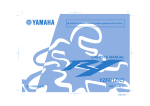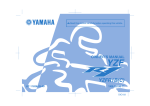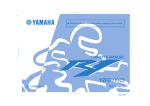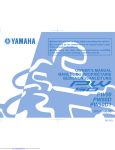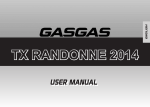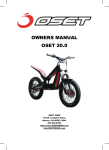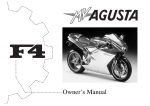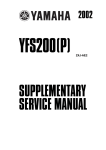Download Yamaha YZFR1Y(C) Specifications
Transcript
YZFR1Y(C) ASSEMBLY MANUAL LIT-11666-22-78 14B-28107-10 FOREWORD This Assembly Manual contains the information required for the correct assembly of this Yamaha vehicle prior to delivery to the customer. Since some external parts of the vehicle have been removed at the Yamaha factory for the convenience of packing, assembly by the Yamaha dealer is required. It should be noted that the assembled vehicle should be thoroughly cleaned, inspected, and adjusted prior to delivery to the customer. IMPORTANT The service specifications given in this assembly manual are based on the model as manufactured. Yamaha Motor Company, Ltd. is continually striving to improve all of its models. Modifications and significant changes in specifications or procedures will be forwarded to all authorized Yamaha dealers and will appear in future editions of this manual where applicable. The procedures below are described in the order that the procedures are carried out correctly and completely. Failure to do so can result in poor performance and possible harm to the vehicle and/or rider. CONCERNING CRATE DAMAGE: Follow the instructions in the Dealer Warranty Handbook, Procedure Section. SYMBOLS USED IN THE ASSEMBLY MANUAL (1) (2) (3) (4) (5) (6) (7) IMPORTANT MANUAL INFORMATION Particularly important information is distinguished in this manual by the following notations. This is the safety alert symbol. It is used to alert you to potential personal injury hazards. Obey all safety messages that follow this symbol to avoid possible injury or death. A WARNING indicates a hazardous situation which, if not avoided, could result in death or serious injury. A NOTICE indicates special precautions that must be taken to avoid damage to the vehicle or other property. A TIP provides key information to make procedures easier or clearer. YZFR1Y(C) ASSEMBLY MANUAL ©2008 by Yamaha Motor Corporation, U.S.A. First Edition, December 2008 All rights reserved. Any reproduction or unauthorized use without the written permission of Yamaha Motor Corporation, U.S.A. is expressly prohibited. Printed in U.S.A. P/N LIT-11666-22-78 (8) In order to simplify descriptions in this assembly manual, the following symbols are used: (1): Coat with lithium-soap-based grease. (2): Tighten to 10 Nm. (10 Nm = 1.0 m•kgf = 7.2 ft•lbf) (3): Towards the front of the vehicle (4): Clearance required (5): Install so that the arrow mark faces upward. (6): Apply motor oil. (7): Made of rubber or plastics (8): A: Ref. No. (indicating the order of operations.) B: Part name C: Quantity of parts per vehicle D: Place where parts are held V: Stored in plastic bag C: Stored in carton box S: Fixed inside the steel frame and/or contained in the Styrofoam tray (upper or lower) *: Temporarily installed or secured E: Size or material of parts d/D: Diameter of part L: Length of part e.g., 5 (0.20) = 5 mm (0.20 in) PREPARATION To assemble the vehicle correctly, supplies (e.g., oils, greases, and shop rags) and sufficient working space are required. Workshop The workshop where the vehicle is assembled should be clean, spacious, and have a level floor. Self-protection Protect your eyes with suitable safety glasses or goggles when using compressed air, when grinding or when doing any operation which may cause particles to fly off. Protect hands and feet by wearing safety gloves or shoes. SYMBOLS USED ON CRATE CARTON (1) (2) (3) (4) (5) (6) (1) Contents of the transport package are fragile, therefore the package must be handled with care. (2) Indicates correct upright position of the transport package. (3) Transport package must be kept away from rain. (4) Insertion of the forklift arms from this side can cause damage. (5) Do not step anywhere on this carton box. (6) Up to 6 of the transport packages can be piled up. (7) Lift arm insertion position If the forklift arms cannot be inserted under the transport package in alignment with the two yellow labels, adjust the arms so that they are positioned evenly in relation to these marks while taking care not to damage the package contents. UNPACKING 1. Remove the frame cover (1). To remove the frame cover, cut the plastic bands around the cover using a cutter or scissors. 2. Remove the bolts (2) and nut (3). 3. Remove the packing frames (4). (Lift up and then move to the side.) • Remove the bolts while holding the frame. • Before starting the assembly, check for damaged or missing parts. Check both the parts contained in the carton boxes and on the vehicle for damage, scratches, and other defects. -1- PARTS LOCATION 1. Carton box 2. Plastic bag -2- Carton box 1 2 3 4 5 6 7 8 9 10 1. 2. 3. 4. 5. 6. Windshield Rear view mirrors Owner's manual Plastic bag Dampers (rear view mirror) Cap nuts (rear view mirror) [d = 6 (0.24)] 7. Collars (rear view mirror) [d = 6.5 (0.26), D = 10.5 (0.41)] 8. Mirror bases (rear view mirror) 9. Plugs (upper bracket) 10. Hexagon socket bolt (rider seat) [d = 6 (0.24), L = 23 (0.91)] Plastic bag 1. Steering stem nut [d = 28 (1.10)] 2. Hexagon socket bolts (handlebar) [d = 6 (0.24), L = 25 (0.98)] 3. Keys -3- SETUP PROCEDURES Perform the setup procedures in the order indicated by the numbers. Always follow the order as shown. 3 4 2 1 5 -4- 1. HANDLEBAR 2,B 113 3 2,B 1,A 3 13 B: To install the clutch cable, be sure to proceed as follows: a. Turn in the adjuster on the lever holder until tight. Next, align the slit in the adjuster and cable socket with the slit in the lever holder. b. Insert the cable end into the lever hole. Next, while pulling the outer cable in the direction opposite to the lever, seat the outer cable into the cable socket. 13 Check the clutch lever for smooth action. Refer to "ADJUSTMENTS AND PREDELIVERY SERVICE". Proper cable routing is essential to assure safe vehicle operation. Refer to "CABLE ROUTING". 3. WINDSHIELD 1,A C 16 C 1 Steering stem nut 1 V 2 Hexagon socket bolt 2 V 3 Plug 2 V 16 d = 28 (1.10) d = 6 (0.24), L = 25 (0.98) A: Tighten the steering stem nut to specification. Steering stem nut 113 Nm (11.3 m•kgf, 82 ft•lbf) B: Tighten the bolts to specification. Bolt 13 Nm (1.3 m•kgf, 9.4 ft•lbf) C: Tighten the bolts to specification. Bolt 16 Nm (1.6 m•kgf, 11 ft•lbf) 1 Windshield 1 C Proper cable routing is essential to assure safe vehicle operation. Refer to "CABLE ROUTING". A: 2. CLUTCH CABLE The windshield is made of an acrylate resin. Take care so that it is not scratched. A B 1 Clutch cable 1 1 * A: Lubricate the pivoting part of the clutch lever. Recommended lubricants Yamaha cable lube or motor oil -5- 4. REAR VIEW MIRRORS 5. BATTERY 4 4 5,C 7,E 7 11,F 5 7 7,E 7 3,B 2 2 1,A 10 4 4 B 3 7 7 6,D C 3 2,A 1 2 3,B 2 1,A 3 2 4 8 9 1 5 1 Damper 2 V 2 Collar 4 V 3 4 5 Mirror base Rear view mirror Cap nut 2 2 4 V C V d = 6.5 (0.26), D = 10.5 (0.41) d = 6 (0.24) A: Be sure to install the dampers between the rear view mirror bracket and the windshield. B: Install the mirror bases on both sides of the vehicle with the one marked "L" facing outward on the left and the one marked "R" facing outward on the right. C: Tighten the nuts to specification. 1 2 3 Battery seat Battery Nut 1 1 2 * * * 4 Bolt 2 * 5 Battery cover 1 * 6 Hexagon socket bolt 2 * 7 Hexagon socket bolt 2 * 1 1 1 * * * Hexagon socket bolt (left) 1 * Hexagon socket bolt (right) 1 V 8 Owner's tool kit 9 Band 10 Rider seat Nut 7 Nm (0.7 m•kgf, 5.1 ft•lbf) 11 d = 6 (0.24) d = 6 (0.24), L = 10 (0.39) d = 6 (0.24), L = 25 (0.98) d = 6 (0.24), L = 20 (0.79) d = 6 (0.24), L = 23 (0.91) d = 6 (0.24), L = 23 (0.91) A: Installing the battery. Refer to "ADJUSTMENTS AND PREDELIVERY SERVICE". B: First, connect the positive lead (red lead) to the positive terminal. C: Second, connect the negative lead (black lead) to the negative terminal. Refer to "CABLE ROUTING". D: Tighten the bolts to specification. Bolt 7 Nm (0.7 m•kgf, 5.1 ft•lbf) E: Tighten the bolts to specification. Bolt 7 Nm (0.7 m•kgf, 5.1 ft•lbf) F: Tighten the bolts to specification. Bolt 7 Nm (0.7 m•kgf, 5.1 ft•lbf) -6- CABLE ROUTING 1,A 3 2 5 Proper cable and lead routing are essential to insure safe vehicle operation. 1. 2. 3. 4. 5. A. Clutch cable Front brake hose Throttle cables Positive battery lead Negative battery lead Route the clutch cable so as to get along the front side of the main switch after passing it through the guide. -7- 4 ADJUSTMENTS AND PREDELIVERY SERVICE Perform the predelivery service in the order indicated by the letters. Always follow the order as shown. O P K L D J B A E L I J J I B M N M M HG C -8- J F A. CHECKING AND CHARGING THE BATTERY The battery used in this vehicle is a VRLA (Valve Regulated Lead Acid) battery, it has been pre-filled with electrolyte at the factory so there is no need to add fluid at any time. 1. Check: Using a digital volt meter, the state of a discharged VRLA (Valve Regulated Lead Acid) battery can be checked by measuring open-circuit voltage (the voltage measured with the positive and negative terminals being disconnected). Open-circuit voltage 12.8 V or higher Charging time Charging is not necessary • Do not attempt boost charging under any circumstances. • Battery electrolyte is poisonous and dangerous, causing severe burns, etc. It contains sulfuric acid. Avoid contact with skin, eyes or clothing. Antidote: External -Flush with water. Internal-Drink large quantities of water or milk. Follow with milk of magnesia, beaten egg, or vegetable oil. Call physician immediately. Eyes: Flush with water for 15 minutes and get prompt medical attention. Batteries produce explosive gases. Keep sparks, flame, cigarettes, etc., away. Ventilate when charging or using in enclosed space. Always shield eyes when working near batteries. KEEP OUT OF THE REACH OF CHILDREN. • If the voltage is lower than 12.8 V the battery must be charged. If this is not done, the life of the battery will be shortened drastically. Refer to the service manual for battery charging instructions. • Never remove the strip of caps, nor add any water or electrolyte. • The tire pressure and the suspension must be adjusted according to the total weight (including cargo, rider, passenger, and accessories) and the anticipated riding speed. • Operation of an overloaded vehicle could cause tire damage, an accident, or an injury. NEVER OVERLOAD THE VEHICLE. Basic weight: With oil and full fuel tank 206 kg (454 lb) Maximum load* 189 kg (417 lb) Cold tire pressure Up to 90 kg (198 lb) load* Front 250 kPa (2.50 kgf/cm2, 36 psi) Rear 290 kPa (2.90 kgf/cm2, 42 psi) 90 kg (198 lb)–Maximum load* Front 250 kPa (2.50 kgf/cm2, 36 psi) Rear 290 kPa (2.90 kgf/cm2, 42 psi) High speed riding Front 250 kPa (2.50 kgf/cm2, 36 psi) Rear 290 kPa (2.90 kgf/cm2, 42 psi) * Load is the total weight of cargo, rider, passenger and accessories. Recommended engine oil type YAMALUBE 4 (10W-40) or SAE 10W40, YAMALUBE 4 (20W-50) or SAE 20W-50 Recommended engine oil grade API service SG type or higher, JASO standard MA Quantity Without oil filter cartridge replacement 3.73 L (3.94 US qt, 3.28 Imp. qt) • Engine oil also lubricates the clutch and the wrong oil types or additives could cause clutch slippage. Therefore, do not add any chemical additives or use engine oils with a grade of CD (c) or higher and do not use oils labeled "ENERGY CONSERVING II" (d). • Do not allow foreign materials to enter the crankcase. c C. CHECKING THE ENGINE OIL LEVEL 1. Stand the vehicle on a level surface. 4 d • Place the vehicle on a suitable stand. • Make sure that the vehicle is upright. 2. Let the engine idle for a few minutes, and then turn it off. 3. Check: • engine oil level The engine oil level should be between the minimum level mark (a) and maximum level mark (b). Below the minimum level mark → Add the recommended engine oil to the proper level. 4. Start the engine, warm it up for several minutes, and then turn it off. 5. Check the engine oil level again. Before checking the engine oil level, wait a few minutes until the oil has settled. • Place the vehicle on a suitable stand. • Make sure that the vehicle is upright. B. MEASURING THE TIRE PRESSURE 1. Measure: • tire pressure Out of specification → Adjust. b a • The tire pressure should only be checked and regulated when the tire temperature equals the ambient air temperature. -9- Before checking the engine oil level, wait a few minutes until the oil has settled. D. CHECKING THE COOLANT LEVEL 1. Stand the vehicle on a level surface. 2. Check: • coolant level The coolant level should be between the minimum level mark (a) and maximum level mark (b). Below the minimum level mark → Add the recommended coolant to the proper level. • Adding water instead of coolant lowers the antifreeze content of the coolant. If water is used instead of coolant, check and correct the antifreeze concentration of the coolant. • Use only distilled water. Soft water may be used if distilled water is not available. 1 a b a F. ADJUSTING THE FRONT BRAKE 1. Adjust: • brake lever position (distance (a) from the throttle grip to the brake lever) a. While pushing the brake lever forward, turn the adjusting knob (1) until the brake lever is in the desired position. b a 3. Start the engine, warm it up for several minutes, and then turn it off. 4. Check: • coolant level Before checking the coolant level, wait a few minutes until it settles. E. ADJUSTING THE THROTTLE CABLE FREE PLAY 1. Measure: • throttle cable free play (a) Out of specification → Adjust. Throttle cable free play (at the flange of the throttle grip) 3–5 mm (0.12–0.20 in) a 2. a. b. c. 2 3 1 Adjust: Slide back the rubber covers (1). Loosen the locknut (2). Turn the adjusting nut (3) in direction (a) or (b) until the specified throttle cable free play is obtained. Direction (a) Throttle cable free play is increased. Direction (b) Throttle cable free play is decreased. d. Tighten the locknut. e. Slide the rubber covers to their original position. After adjusting the throttle cable free play, turn the handlebar to the right and to the left to ensure that this does not cause the engine idling speed to change. Be sure to align the setting on the adjusting knob with the arrow mark (2) on the brake lever. Direction (b) Distance (a) is increased. Direction (c) Distance (a) is decreased. 2. Adjust: • brake pedal position a. Loosen the locknut (1). b. Turn the adjusting bolt (2) in direction (a) or (b) until the specified brake pedal position is obtained. Direction (a) Brake pedal is raised. Direction (b) Brake pedal is lowered. After adjusting the brake pedal position, make sure that the end of the adjusting bolt (c) is visible through the hole (d). After adjusting the brake lever position, make sure that there is no brake drag. A soft or spongy feeling in the brake lever can indicate the presence of air in the brake system. Before the vehicle is operated, the air must be removed by bleeding the brake system. Air in the brake system will considerably reduce braking performance and could result in loss of control and possibly an accident. Therefore, check the brake system and bleed if necessary. 1 c. Tighten the locknut to specification. Locknut 16 Nm (1.6 m•kgf, 11 ft•lbf) A soft or spongy feeling in the brake pedal can indicate the presence of air in the brake system. Before the vehicle is operated, the air must be removed by bleeding the brake system. Air in the brake system will considerably reduce braking performance and could result in loss of control and possibly an accident. Therefore, check the brake system and bleed if necessary. a b 2 After adjusting the brake pedal position, make sure that there is no brake drag. c G. ADJUSTING THE REAR BRAKE 1. Measure: • brake pedal position (distance (a) from the center of the footrest bracket bolt to the center of the brake pedal) Out of specification → Adjust. Brake pedal position (below the center of the footrest bracket bolt) 12–18 mm (0.47–0.71 in) -10- H. ADJUSTING THE REAR BRAKE LIGHT SWITCH • The rear brake light switch is operated by the movement of the brake pedal. • The rear brake light switch is properly adjusted when the brake light comes on just before the braking effect starts. 1. Check: • rear brake light operation timing Incorrect → Adjust. 2. Adjust: • rear brake light operation timing a. Hold the main body (1) of the rear brake light switch so that it does not rotate and turn the adjusting nut (2) in direction (a) or (b) until the rear brake light comes on at the proper time. 2 a 1 Direction (a) Brake light comes on sooner. Direction (b) Brake light comes on later. 1 a 2 a b A. B. I. CHECKING THE BRAKE FLUID LEVEL Front brake Rear brake J. BLEEDING THE HYDRAULIC BRAKE SYSTEM 1. Stand the vehicle on a level surface. • Place the vehicle on a suitable stand. • Make sure that the vehicle is upright. 2. Check: • brake fluid level Below the minimum level mark (a) → Add the recommended brake fluid to the proper level. Recommended brake fluid DOT 4 • Use only designated brake fluid. Other brake fluids may cause the rubber seals to deteriorate, causing leakage and poor brake performance. • Refill with the same type of brake fluid that is already in the system. Mixing brake fluids may result in a harmful chemical reaction, leading to poor brake performance. • When refilling, be careful that water does not enter the reservoir. Water will significantly lower the boiling point of the brake fluid and could cause vapor lock. Brake fluid may damage painted surfaces and plastic parts. Therefore, always clean up any split brake fluid immediately. Bleed the hydraulic brake system whenever: • the system was disassembled, • a brake hose was loosened or removed, • the brake fluid level is very low, • brake operation is faulty. • Be careful not to spill any brake fluid or allow the brake fluid reservoir to overflow. • When bleeding the hydraulic brake system, make sure that there is always enough brake fluid before applying the brake. Ignoring this precaution could allow air to enter the hydraulic brake system, considerably lengthening the bleeding procedure. • If bleeding is difficult, it may be necessary to let the brake fluid settle for a few hours. Repeat the bleeding procedure when the tiny bubbles in the hose have disappeared. 1. Bleed: • hydraulic brake system a. Add the recommended brake fluid to the proper level. b. Install the brake fluid reservoir diaphragm. c. Connect a clear plastic hose (1) tightly to the bleed screw (2). 2 1 In order to ensure a correct reading of the brake fluid level, make sure that the top of the reservoir is level. A. B. C. Front brake master cylinder Front brake caliper Rear brake caliper The bleeding order of the front hydraulic brake system is the following: • Front brake master cylinder • Front brake calipers • Front brake master cylinder d. Place the other end of the hose into a container. e. Slowly apply the brake several times. f. Fully squeeze the brake lever or fully depress the brake pedal and hold it in position. g. Loosen the bleed screw. This will release the tension and cause the brake lever to contact the throttle grip or the brake pedal to fully extend. h. Tighten the bleed screw and then release the brake lever or brake pedal. i. Repeat steps (e) to (h) until all of the air bubbles have disappeared from the brake fluid in the plastic hose. j. Tighten the bleed screw to specification. Bleed screw Brake caliper 5 Nm (0.5 m•kgf, 3.6 ft•lbf) Brake master cylinder 6 Nm (0.6 m•kgf, 4.3 ft•lbf) k. Fill the reservoir to the proper level. Refer to "CHECKING THE BRAKE FLUID LEVEL". After bleeding the hydraulic brake system, check the brake operation. K. ADJUSTING THE CLUTCH CABLE FREE PLAY 1. Measure: • clutch cable free play (a) Out of specification → Adjust. Clutch cable free play (at the end of the clutch lever) 10–15 mm (0.39–0.59 in) -11- 2. Adjust: • clutch cable free play a. Turn the adjusting bolt (1) in direction (b) or (c) until the specified clutch cable free play is obtained. 1 a b Direction (b) Clutch cable free play is increased. Direction (c) Clutch cable free play is decreased. Rebound damping (right front fork leg) Never go beyond the maximum or minimum adjustment positions. 1. Adjust: • rebound damping a. Turn the adjusting screw (1) in direction (a) or (b). L. ADJUSTING THE FRONT FORK LEGS Securely support the vehicle so that there is no danger of it falling over. Spring preload The following procedure applies to both of the front fork legs. Always adjust both front fork legs evenly. Uneven adjustment can result in poor handling and loss of stability. Direction (a) Rebound damping is increased (suspension is harder). Direction (b) Rebound damping is decreased (suspension is softer). Adjusting positions Standard: 12 clicks out* Minimum: 25 clicks out* Maximum: 1 click out* *: from the fully turned-in position b 1 • Grooves are provided to indicate the adjustment position. • Never go beyond the maximum or minimum adjustment positions. Direction (a) Spring preload is increased (suspension is harder). Direction (b) Spring preload is decreased (suspension is softer). 1 a b Adjusting positions Standard: 2 Minimum: 0 Maximum: 5 Securely support the vehicle so that there is no danger of it falling over. Spring preload Never go beyond the maximum or minimum adjustment positions. 1. Adjust: • spring preload a. Turn the adjusting bolt (1) in direction (a) or (b). b. Align the match mark (3) with the " △ " mark (2). Direction (a) Spring preload is increased (suspension is harder). Direction (b) Spring preload is decreased (suspension is softer). Adjusting positions Standard: 8 turns out* Minimum: 16 turns out* Maximum: 0 turn out* *: from the fully turned-in position a 1. Adjust: • spring preload a. Turn the adjusting bolt (1) in direction (a) or (b). M. ADJUSTING THE REAR SHOCK ABSORBER ASSEMBLY Compression damping (left front fork leg) Never go beyond the maximum or minimum adjustment positions. 1. Adjust: • compression damping a. Turn the adjusting screw (1) in direction (a) or (b). Direction (a) Compression damping is increased (suspension is harder). Direction (b) Compression damping is decreased (suspension is softer). Adjusting positions Standard: 20 clicks out* Minimum: 25 clicks out* Maximum: 1 click out* *: from the fully turned-in position -12- 3 1 2 a b Rebound damping Never go beyond the maximum or minimum adjustment positions. 1. Adjust: • rebound damping a. Turn the adjusting screw (1) in direction (a) or (b). Direction (a) Rebound damping is increased (suspension is harder). Direction (b) Rebound damping is decreased (suspension is softer). Adjusting positions Standard: 15 clicks out* Minimum: 20 clicks out* Maximum: 3 clicks out* *: from the fully turned-in position A drive chain that is too tight will overload the engine and other vital parts, and one that is too loose can skip and damage the swingarm or cause an accident. Therefore, keep the drive chain slack within the specified limits. 1. Stand the vehicle on a level surface. a 1 b Securely support the vehicle so that there is no danger of it falling over. Compression damping O. ADJUSTING THE HEADLIGHT BEAMS The following procedure applies to both of the headlights. 1. Adjust: • headlight beam (vertically) a. Turn the adjusting screw (1) in direction (a) or (b). Direction (a) Headlight beam is raised. Direction (b) Headlight beam is lowered. Both wheels should be on the ground without a rider on the vehicle. Never go beyond the maximum or minimum adjustment positions. 1. Adjust: • high compression damping a. Turn the adjusting bolt (1) in direction (a) or (b). Direction (a) High compression damping is increased (suspension is harder). Direction (b) High compression damping is decreased (suspension is softer). 2. Rotate the rear wheel several times and check the drive chain to locate its tightest point. 3. Measure: • drive chain slack (a) Out of specification → Adjust. Drive chain slack 20–30 mm (0.79–1.18 in) Adjusting positions Standard: 3 turns out* Minimum: 4 turns out* Maximum: 0 turn out* *: from the fully turned-in position • low compression damping a. Turn the adjusting bolt (2) in direction (a) or (b). Direction (a) Low compression damping is increased (suspension is harder). Direction (b) Low compression damping is decreased (suspension is softer). Adjusting positions Standard: 9 clicks out* Minimum: 20 clicks out* Maximum: 1 click out* *: from the fully turned-in position a Locknut 16 Nm (1.6 m•kgf, 11 ft•lbf) a Direction (a) Drive chain is tightened. Direction (b) Drive chain is loosened. To maintain the proper wheel alignment, adjust both sides evenly. 1 3 2 a b b The drive chain slack must be checked at the tightest point on the chain. b 1 2. Adjust: • headlight beam (horizontally) a. Turn the adjusting screw (1) in direction (a) or (b). a 4. Loosen: • wheel axle nut (1) 5. Adjust: • drive chain slack a. Loosen both locknuts (2). b. Turn both adjusting bolts (3) in direction (a) or (b) until the specified drive chain slack is obtained. 2 ba Direction (a) Headlight beam moves to the right. Direction (b) Headlight beam moves to the left. 1 N. ADJUSTING THE DRIVE CHAIN SLACK a b b a 1 P. ADJUSTING THE DIGITAL CLOCK 1. Turn the key to "ON". 2. Adjust: • digital clock (1) a. Push the "SELECT" button (2) and "RESET" button (3) together for at least two seconds. b. When the hour digits start flashing, push the "RESET" button to set the hours. c. Push the "SELECT" button, and the minute digits will start flashing. d. Push the "RESET" button to set the minutes. e. Push the "SELECT" button and then release it to start the clock. 2 c. Tighten the wheel axle nut to specification. Wheel axle nut 150 Nm (15.0 m•kgf, 110 ft•lbf) d. Tighten the locknuts to specification. -13- 3 1 APPENDICES SERVICE DATA Engine idling speed: 1,150–1,250 r/min Spark plug: Type (manufacturer) LMAR9E-J (NGK) Gap 0.6–0.7 mm (0.024–0.028 in) Fuel: Recommended fuel Premium unleaded gasoline only Fuel tank capacity Total: 18.0 L (4.76 US gal, 3.96 Imp. gal) Valve clearance (cold): IN 0.11–0.20 mm (0.0043–0.0079 in) EX 0.21–0.25 mm (0.0083–0.0098 in) Maximum load*: 189 kg (417 lb) Tire pressure: Up to 90 kg (198 lb) load* Front 250 kPa (2.50 kgf/cm2, 36 psi) Rear 290 kPa (2.90 kgf/cm2, 42 psi) 90 kg (198 lb) load–Maximum load* Front 250 kPa (2.50 kgf/cm2, 36 psi) Rear 290 kPa (2.90 kgf/cm2, 42 psi) High-speed riding Front 250 kPa (2.50 kgf/cm2, 36 psi) Rear 290 kPa (2.90 kgf/cm2, 42 psi) * Load is the total weight of cargo, rider, passenger, and accessories. STANDARD EQUIPMENT Owner's manual × 1 Owner's tool kit × 1 OWNER'S TOOL KIT Owner's tool box × 1 Wrench (8-10) × 1 Wrench (10-12) × 1 Wrench (12-14) × 1 Special wrench × 1 Extension bar × 1 Screwdriver grip × 1 Screwdriver bit (Phillips-slotted) × 1 Spark plug wrench × 1 Pliers × 1 Hexagon wrench (3) × 1 Hexagon wrench (4) × 1 Hexagon wrench (5) × 1 Sponge sheet × 1 (to serve as a buffer between the tools and the owner's tool box wall) -14- TIGHTENING TORQUE Item Thread size Engine: Spark plug Engine oil drain bolt Chassis: Engine mounting bolt (front side) Engine mounting nut (rear side) Engine mount adjusting bolt Clutch cable locknut (engine side) Main frame and rear frame bolt Battery cover bolt Upper tail cover bracket bolt Swingarm pivot shaft Swingarm pivot shaft ring nut Swingarm pivot shaft nut Relay arm and frame nut Relay arm and connecting arm nut Connecting arm and swingarm nut Rear shock absorber assembly lower nut Rear shock absorber assembly upper nut Rear shock absorber upper bracket nut Drive chain guide bolt Drive chain guard bolt Locknut (drive chain adjusting bolt) Upper bracket pinch bolt Steering stem nut Handlebar pinch bolt Handlebar bolt Lower ring nut Lower bracket pinch bolt Main switch bolt Brake master cylinder reservoir cap screw Front brake hose union bolt Front brake master cylinder bolt Handlebar end grip bolt Front brake hose joint bracket bolt Coolant reservoir bolt Air chamber bracket bolt Left lower cowling bracket bolt Left lower cowling bracket and radiator outlet pipe bolt Right lower cowling bracket bolt Left side cowling inner panel bolt Right side cowling inner panel bolt Meter bracket bolt Meter bracket ground lead bolt Rear view mirror nut Fuel pump bolt Front fuel tank bracket bolt Fuel tank bolt (front) Rear fuel tank bracket bolt Fuel tank bolt (rear) Fuel tank upper cover bolt (front) Fuel tank upper cover bolt (rear) Fuel tank side cover screw Rider seat bolt Seat lock plate bolt Front wheel axle bolt Rear wheel axle nut Front brake caliper bolt Front brake disc bolt Rear brake disc bolt Rear wheel sprocket nut -15- Nm Tightening torque m•kgf ft•lbf M10 M14 13 43 1.3 4.3 9.4 31 M12 M10 M18 M8 M10 M6 M6 M30 M30 M20 M10 M10 M10 M10 M10 M16 M6 M6 M8 M8 M28 M8 M6 M30 M8 M8 M4 M10 M6 M6 M6 M6 M6 M6 M6 M6 M6 M6 M8 M5 M6 M5 M6 M6 M6 M6 M6 M5 M5 M6 M6 M14 M24 M10 M6 M8 M10 70 51 7 7 41 7 7 7 65 105 40 40 40 40 40 92 7 7 16 26 113 16 13 7.0 5.1 0.7 0.7 4.1 0.7 0.7 0.7 6.5 10.5 4.0 4.0 4.0 4.0 4.0 9.2 0.7 0.7 1.6 2.6 11.3 1.6 1.3 See TIP. 2.3 — 0.1 3.0 1.3 0.4 1.1 0.5 0.7 0.7 0.7 0.9 0.5 0.5 2.3 0.6 0.7 0.4 0.9 0.7 0.7 0.7 0.7 0.4 0.4 0.7 0.7 9.1 15.0 3.5 1.8 3.0 10.0 50 37 5.1 5.1 30 5.1 5.1 5.1 47 75 29 29 29 29 29 66 5.1 5.1 11 19 82 11 9.4 23 — 1 30 13 4 11 5 7 7 7 9 5 5 23 6 7 4 9 7 7 7 7 4 4 7 7 91 150 35 18 30 100 17 — 0.7 22 9.4 2.9 8.0 3.6 5.1 5.1 5.1 6.5 3.6 3.6 17 4.3 5.1 2.9 6.5 5.1 5.1 5.1 5.1 2.9 2.9 5.1 5.1 66 110 25 13 22 72 Item Thread size Front brake master cylinder bleed screw Brake caliper bleed screw Front wheel axle pinch bolt Rider footrest bolt Passenger footrest bolt Rear frame lower reinforcement bolt Rear brake master cylinder bolt Rear brake hose union bolt Sidestand bracket bolt Battery box bolt Lean angle sensor bolt Mudguard stay bolt Mudguard bolt Catalytic converter cover bolt M8 M8 M8 M8 M8 M6 M6 M10 M10 M6 M4 M6 M6 M6 Nm 6 5 28 28 13 13 30 63 7 2 7 10 7 Tightening torque m•kgf ft•lbf 0.6 4.3 0.5 3.6 See TIP. 2.8 20 2.8 20 1.3 9.4 1.3 9.4 3.0 22 6.3 45 0.7 5.1 0.2 1.4 0.7 5.1 1.0 7.2 0.7 5.1 Lower ring nut 1. First, tighten the lower ring nut to approximately 52 Nm (5.2 m•kgf, 37 ft•lbf) with a torque wrench, then loosen the lower ring nut completely. 2. Retighten the lower ring nut to 18 Nm (1.8 m•kgf, 13 ft•lbf) with a torque wrench. Front wheel axle pinch bolt 1. Insert the front wheel axle from the right side and tighten it with the flange bolt from the left side to 91 Nm (9.1 m•kgf, 66 ft•lbf) without performing temporary tightening. 2. In the order pinch bolt (2) → pinch bolt (1) → pinch bolt (2), tighten each bolt to 21 Nm (2.1 m•kgf, 15 ft•lbf) without performing temporary tightening. 3. Check that the right end of the front axle is flush with the front fork. If necessary, manually push the front axle or lightly tap it with a soft hammer until its end is flush with the front fork. However, if the surface of the front axle end is not parallel to the surface of the front fork, align a point on the outer edge of the axle with the fork, making sure that the axle does not protrude past the fork. 4. In the order pinch bolt (4) → pinch bolt (3) → pinch bolt (4), tighten each bolt to 21 Nm (2.1 m•kgf, 15 ft•lbf) without performing temporary tightening. 2 1 4 3 -16- YAMAHA MOTOR CO., LTD. 2500 SHINGAI IWATA SHIZUOKA JAPAN PRINTED IN U.S.A.




















